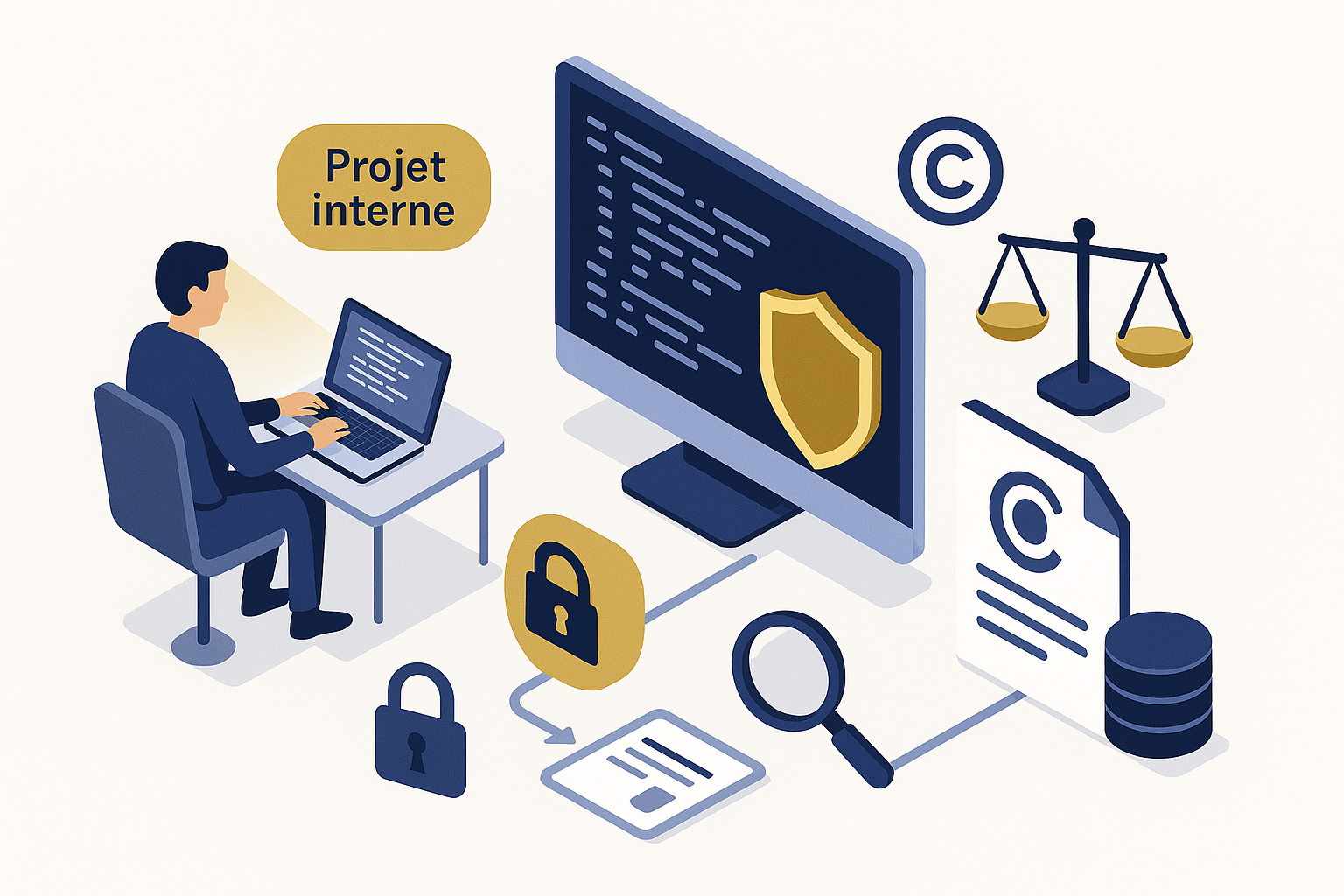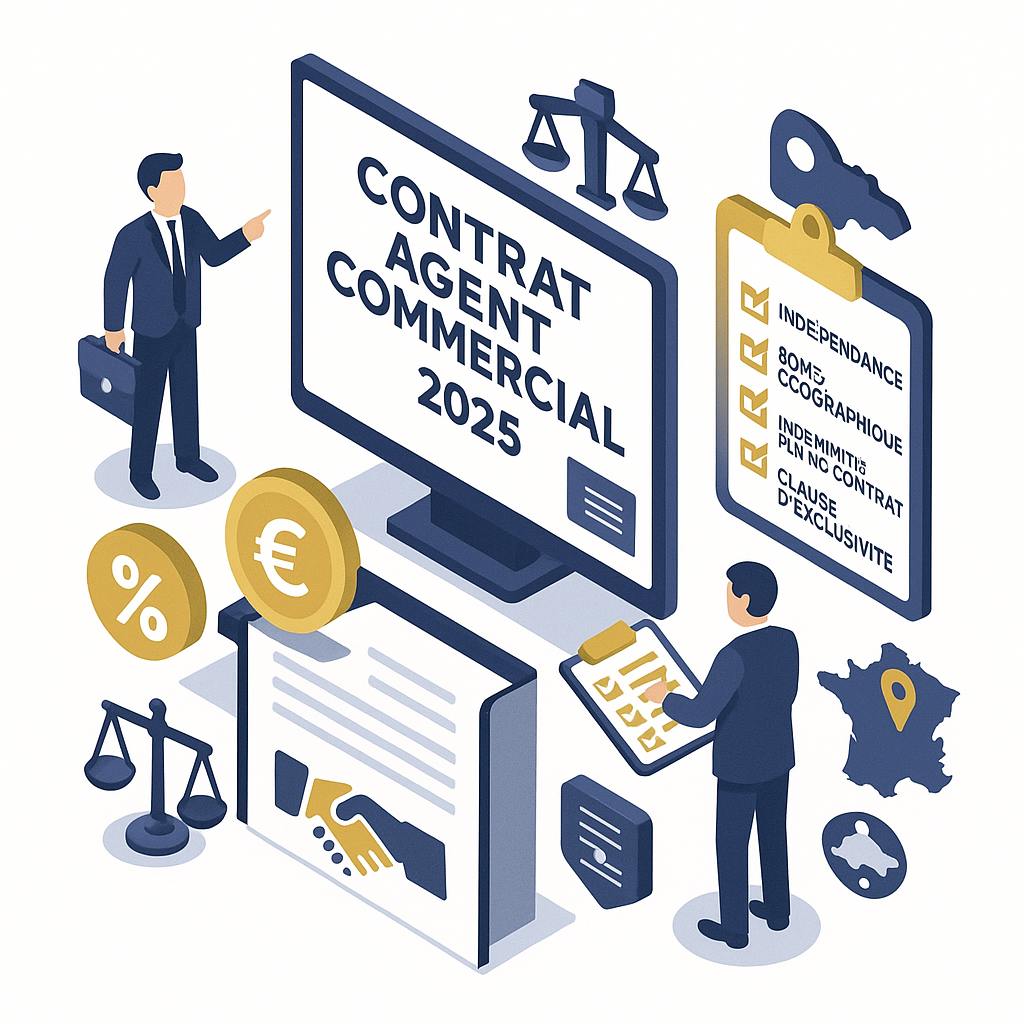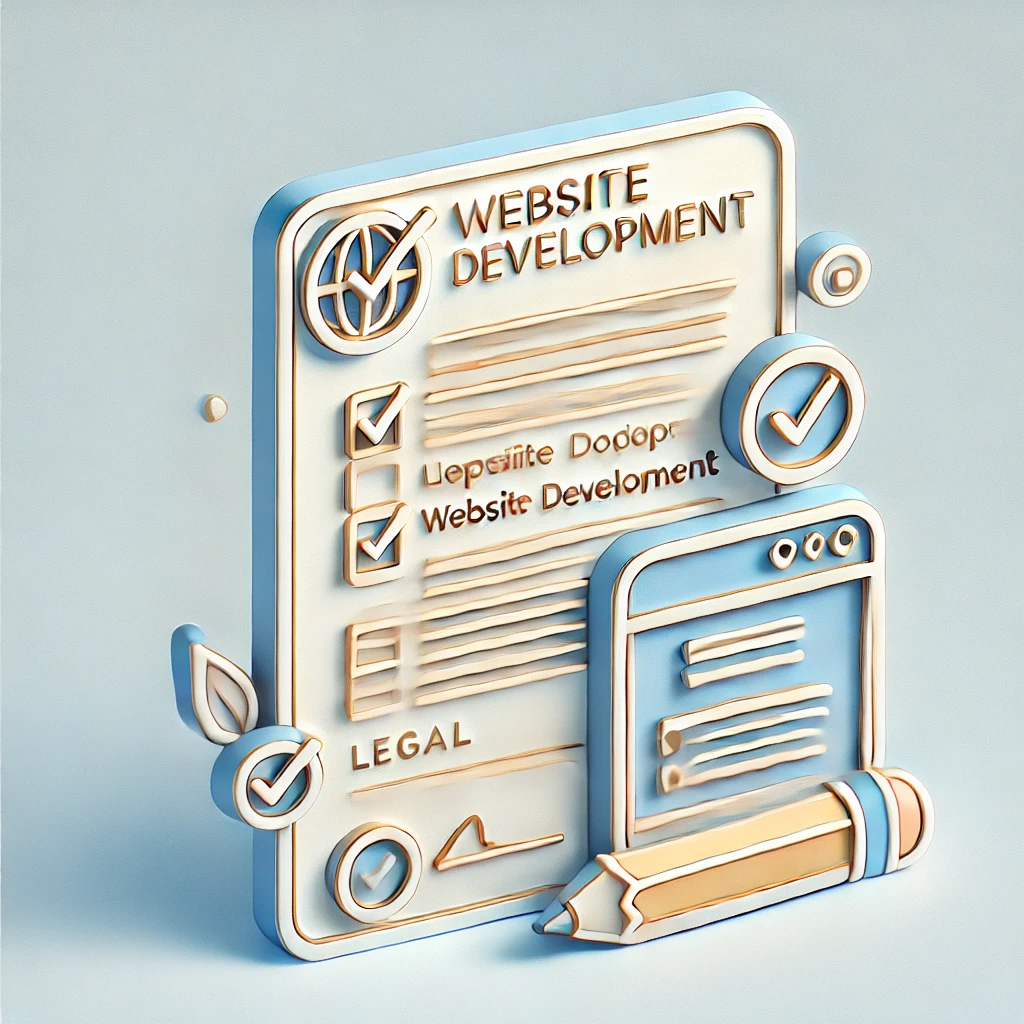In-house software development raises complex legal issues concerning intellectual property.
In-house software development is now a key pillar of innovation and digital transformation strategies. These intangible assets, often at the heart of competitive advantage, nevertheless raise complex legal issues that many organizations underestimate.
Between copyright, employment contracts and the protection of innovations, the legal framework surrounding in-house software development deserves special attention to ensure the long-term security of these strategic investments.
If you're looking for a software and database lawyer, contact me!
The legal status of software: specific protection
Under French law, software enjoys special protection under copyright law. Contrary to popular belief, protection applies automatically from the moment of creation, without the need for prior registration or deposit. This protection covers not only source and object code, but also preparatory documentation, interfaces and the general structure of the program.
This protection extends over the lifetime of the author, more than 70 years after his or her death, offering long-term exclusivity. It confers essential prerogatives on the rights holder: the right to reproduce, the right to adapt, the right to distribute and the right to correct errors. These economic rights are accompanied by a limited moral right for software, mainly focused on the right to authorship of the work.
The specificity of the software regime is also reflected in particular exceptions, such as the limited right to decompile for interoperability purposes, or the possibility of making a back-up copy. These legal nuances shape the framework within which all in-house development takes place, and need to be perfectly mastered by management and technical teams.
The thorny issue of rights ownership
Software developed by employees: automatic vesting subject to conditions
The most critical issue concerns the ownership of rights to software developed in-house. Contrary to the general copyright regime, article L.113-9 of the French Intellectual Property Code provides for automatic devolution of rights to the employer when software is created by one or more employees in the performance of their duties or on the employer's instructions.
This exception to the principle that the author is the first owner of the rights considerably simplifies the situation for companies. However, this automatic devolution remains subject to several cumulative conditions that must be scrupulously verified:
- The developer must have employee status (legal subordination).
- Development must be carried out in the performance of duties or on the instructions of the employer
- Creation must take place during the term of the employment contract
Case law has gradually clarified these notions, requiring in particular that software development corresponds to the tasks entrusted to the employee. Development carried out outside working hours, or which manifestly exceeds the skills expected of the position, could thus escape this automatic devolution, creating a situation of co-ownership that is complex to manage.
The situation is radically different for non-salaried developers (interns, work-study students, corporate officers): the law makes no provision for automatic devolution. An express transfer of rights is therefore essential, or else you will find yourself legally unable to exploit the software you have developed to the full.
External service providers and subcontractors: the need for formal assignment
The use of external service providers to complement in-house teams in software development is common practice. However, this hybrid approach entails major legal risks in terms of intellectual property if contracts are not properly structured.
Unlike developments carried out by employees, those created by external service providers remain in principle the property of the latter. An explicit assignment of economic rights is therefore imperative. This assignment must meet strict formal requirements, specified by article L.131-3 of the French Intellectual Property Code: it must be in writing, and precisely define the field of exploitation of the assigned rights, the geographical scope and the duration of the assignment.
The wording of these assignment clauses requires particular care. Wording that is too vague or incomplete can render the assignment partially ineffective, limiting the company's ability to exploit, modify or assign the software at a later date. Courts interpret assignment contracts restrictively, to the benefit of the author.
To navigate these legal complexities and secure your in-house software developments, it is advisable to consult a software and database lawyer who will be able to analyze your specific situation and set up a suitable contractual framework.
The challenges of collaborative projects and co-development
The growing trend towards collaborative developments, involving several distinct legal entities, further complicates the issue of rights ownership. These partnerships, often essential to innovation, create situations of intellectual co-ownership that require a rigorous contractual framework.
Consortium or co-development contracts need to anticipate a number of scenarios: the initial distribution of rights to joint creations, the terms of use by each partner, the conditions for software evolution, and the rules for sharing any revenues. Without this prior framework, subsequent management of the software can become a real legal headache, requiring the unanimous agreement of the co-owners for any significant decision.
The question of the initial contributions of each partner deserves particular attention. These pre-existing elements, integrated into the joint project, must be clearly identified and their use precisely defined. A detailed inventory, appended to the main contract, is a good practice to avoid later disputes over the ownership of certain components.
For projects involving public-sector bodies (universities, research laboratories), specific rules may apply, notably concerning the valorization of results and publication. These public-private partnerships call for heightened vigilance and in-depth knowledge of institutional intellectual property policies.
The challenge of open source in proprietary developments
The integration of open source components into in-house developments has become standard practice, enabling companies to accelerate development cycles and benefit from proven solutions. However, this practice is not without legal risk, as open source licenses impose various obligations that can contaminate the software as a whole.
The diversity of open source licenses (GPL, LGPL, MIT, Apache, BSD...) and their varying legal implications require case-by-case analysis. Some so-called "copyleft" licenses, such as the GPL, require derivative works to be distributed under the same conditions, and may thus compel publication of the source code of the entire software. Other, more permissive licenses authorize integration into proprietary solutions, with no obligation to share the code.
A precise mapping of the open source components used, combined with a license compatibility analysis, should be an integral part of the development process. This helps to identify legal risks at an early stage, and to adapt the development strategy accordingly, for example by isolating components subject to restrictive licenses, or by considering proprietary alternatives for critical elements.
In addition to redistribution obligations, open source licenses generally include warranty disclaimers and limitation of liability clauses, which can impact a company's ability to guarantee its own software. These contractual aspects must be taken into account in the license conditions offered to end-users.
Protection strategies complementary to copyright
While copyright is the cornerstone of software protection, other legal mechanisms can be mobilized to reinforce this protection and secure the investment made.
Registration and proof of prior art
Establishing proof of anteriority is essential to effectively defend one's rights in the event of litigation. Several complementary mechanisms can be implemented:
- Deposit with the Agence pour la Protection des Programmes (APP), a specialized agency offering certified dating and secure storage services.
- Filing with a bailiff or notary, particularly relevant for major software versions
- The use of qualified electronic time-stamping systems that comply with the eIDAS regulation
- Setting up an internal chain of evidence documenting the development process
These mechanisms do not create any new rights, but considerably facilitate the administration of proof in the event of a dispute, notably to establish the anteriority and originality of the software.
Patent protection: a limited but strategic option
Unlike in the USA, European law in principle excludes software "as such" from patentability. However, a computer-implemented invention can be protected by patent if it makes a technical contribution that goes beyond the simple interaction between software and hardware.
This route to protection remains complex and uncertain, but can prove strategic for significant technical innovations. The drafting of claims requires particular expertise to circumvent the exclusion in principle, while maximizing the scope of protection. In-depth consideration of the cost/benefit ratio must precede any approach to patentability, taking into account the time required to obtain the patent and the public disclosure inherent in this procedure.
Business secrecy and confidentiality measures
For non-visible aspects of software, notably complex algorithms or innovative methods, business secrecy protection can provide a relevant alternative or complement to copyright. Since the law of July 30, 2018, transposing the European directive on business secrecy, this regime offers enhanced protection against the misappropriation of commercially sensitive information.
To benefit from this protection, the company must implement reasonable confidentiality measures and demonstrate the commercial value of the information kept secret. In concrete terms, this means :
- Confidentiality agreements (NDA) with all parties having access to the source code
- Technical protection measures (restricted access, encryption, traceability)
- A documented safety policy and regular training courses
- Clear classification of information according to its level of sensitivity
This approach is particularly well suited to software for internal use or cloud solutions (SaaS) whose code is not distributed to users.
Valuing software assets as company assets
Software developed in-house is an intangible asset whose economic value can be considerable. The accounting and valuation of these assets represent a strategic challenge, both for the company's financial image and for potential sales or fund-raising operations.
Accounting and tax issues
From an accounting point of view, software development costs can be capitalized under certain conditions, enabling them to be recorded as assets on the balance sheet rather than as an expense for the year. This option, provided for in article 311-3 of the French General Chart of Accounts, is subject to six cumulative criteria, including technical feasibility, the intention to complete the development and the probability of future economic benefits.
This capitalization offers several advantages: improved financial ratios, spreading of the impact on earnings via amortization, and the possibility of benefiting from the Research Tax Credit (CIR) for eligible developments. Rigorous documentation of the development process and associated costs becomes a major challenge in justifying these accounting and tax treatments.
Software asset audit and due diligence
In the context of mergers & acquisitions or capital raising operations, software developed in-house is systematically subjected to in-depth audits (due diligence). These examinations focus not only on the technical and commercial value of the solutions, but also on the solidity of the chain of rights and the associated legal risks.
The ability to demonstrate full ownership of the software developed, the absence of problematic third-party components, and compliance with legal obligations (particularly in terms of data protection) can significantly influence the company's valuation and the terms of the transaction.
To prepare for these deadlines, a preventive audit of software assets is recommended, enabling any weaknesses in the chain of rights to be identified and corrected upstream. This proactive approach secures intangible assets and facilitates future operations by reducing legal uncertainty.
Practical recommendations for securing in-house developments
Ensuring the legal security of software developed in-house requires a proactive, structured approach, ideally integrated right from the project design stage. Several concrete measures can be implemented:
- Include specific clauses relating to IT developments in the employment contracts of the employees concerned
- Draw up appropriate model contracts for the various categories of external service providers involved in development.
- Implement a systematic procedure for qualifying and analyzing third-party components, especially open source ones.
- Develop a filing and documentation policy to establish proof of prior art
- Train technical teams in the legal challenges of software development
- Create and maintain a software asset register, listing all developments and their legal status
Ces mesures préventives, bien que représentant un investissement initial, constituent une assurance contre des risques juridiques potentiellement bien plus coûteux à long terme. L’accompagnement d’un avocat spécialisé en droit du numérique est précieux pour mettre en place ces dispositifs.
The international dimension of software development
The globalization of development teams, facilitated by remote working, adds an international dimension to intellectual property issues. Developments involving contributors based in different countries require in-depth analysis of the applicable legislation and how it relates to each other.
While the principle of territoriality of copyright remains the rule, international conventions (notably the Berne Convention) ensure mutual recognition of rights between signatory countries. However, significant differences remain in terms of ownership regimes, particularly for salaried creations.
In some jurisdictions, such as the United States with its "work made for hire" doctrine, the devolution of rights to the employer is more extensive than in French law. Conversely, other legal systems may be more restrictive, requiring formal assignments even for developments made by employees.
This legal complexity argues in favor of a unified approach, ideally via a framework contract specifying the applicable law and consolidating all transfers of rights, irrespective of the location of the contributors. Particular attention must be paid to local mandatory rules that could limit the effectiveness of such contractual provisions.
To sum up
The legal aspects of software developed in-house may seem technical and restrictive, but mastering them is a real competitive advantage. Rigorous management of intellectual property not only secures the investments made, but also enables us to envisage a variety of value-adding strategies: direct monetization, licensing to third parties, or integration into broader offerings.
Far from being a simple question of compliance, the legal structuring of software developments must form part of a company's overall strategy. It protects innovation, avoids costly litigation, and maximizes the value of the intangible assets created.
In an economic environment where value is increasingly based on intangible assets, transforming computer code into legally secure capital is becoming a strategic imperative that innovative organizations cannot ignore.




